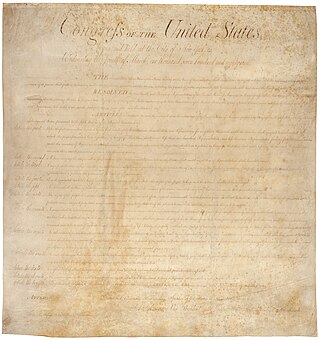
A constitution is the aggregate of fundamental principles or established precedents that constitute the legal basis of a polity, organization or other type of entity, and commonly determines how that entity is to be governed.

The First Amendment to the United States Constitution prevents Congress from making laws respecting an establishment of religion; prohibiting the free exercise of religion; or abridging the freedom of speech, the freedom of the press, the freedom of assembly, or the right to petition the government for redress of grievances. It was adopted on December 15, 1791, as one of the ten amendments that constitute the Bill of Rights. In the original draft of the Bill of Rights, what is now the First Amendment occupied third place. The first two articles were not ratified by the states, so the article on disestablishment and free speech ended up being first.

The Fourteenth Amendment to the United States Constitution was adopted on July 9, 1868, as one of the Reconstruction Amendments. Usually considered one of the most consequential amendments, it addresses citizenship rights and equal protection under the law and was proposed in response to issues related to formerly enslaved Americans following the American Civil War. The amendment was bitterly contested, particularly by the states of the defeated Confederacy, which were forced to ratify it in order to regain representation in Congress. The amendment, particularly its first section, is one of the most litigated parts of the Constitution, forming the basis for landmark Supreme Court decisions such as Brown v. Board of Education (1954) regarding racial segregation, Loving v. Virginia (1967) regarding interracial marriage, Roe v. Wade (1973) regarding abortion, Bush v. Gore (2000) regarding the 2000 presidential election, Obergefell v. Hodges (2015) regarding same-sex marriage, and Students for Fair Admissions v. Harvard (2023) regarding race-based college admissions. The amendment limits the actions of all state and local officials, and also those acting on behalf of such officials.
Civil liberties are guarantees and freedoms that governments commit not to abridge, either by constitution, legislation, or judicial interpretation, without due process. Though the scope of the term differs between countries, civil liberties may include the freedom of conscience, freedom of press, freedom of religion, freedom of expression, freedom of assembly, the right to security and liberty, freedom of speech, the right to privacy, the right to equal treatment under the law and due process, the right to a fair trial, and the right to life. Other civil liberties include the right to own property, the right to defend oneself, and the right to bodily integrity. Within the distinctions between civil liberties and other types of liberty, distinctions exist between positive liberty/positive rights and negative liberty/negative rights.

The Canadian Charter of Rights and Freedoms, often simply referred to as the Charter in Canada, is a bill of rights entrenched in the Constitution of Canada, forming the first part of the Constitution Act, 1982. The Charter guarantees certain political rights to Canadian citizens and guarantees the civil rights of everyone in Canada. It is designed to unify Canadians around a set of principles that embody those rights. The Charter was proclaimed in force by Queen Elizabeth II of Canada on April 17, 1982, as part of the Constitution Act, 1982.
Griswold v. Connecticut, 381 U.S. 479 (1965), was a landmark decision of the U.S. Supreme Court in which the Court ruled that the Constitution of the United States protects the liberty of married couples to use contraceptives without government restriction. The case involved a Connecticut "Little Comstock Act" that prohibited any person from using "any drug, medicinal article or instrument for the purpose of preventing conception". The court held that the statute was unconstitutional, and that its effect was "to deny disadvantaged citizens ... access to medical assistance and up-to-date information in respect to proper methods of birth control." By a vote of 7–2, the Supreme Court invalidated the law on the grounds that it violated the "right to marital privacy", establishing the basis for the right to privacy with respect to intimate practices. This and other cases view the right to privacy as "protected from governmental intrusion".
A constitutional amendment is a modification of the constitution of a polity, organization or other type of entity. Amendments are often interwoven into the relevant sections of an existing constitution, directly altering the text. Conversely, they can be appended to the constitution as supplemental additions, thus changing the frame of government without altering the existing text of the document.

The Spanish Constitution is the supreme law of the Kingdom of Spain. It was enacted after its approval in a constitutional referendum; it represents the culmination of the Spanish transition to democracy.

The Constitution of the Commonwealth of Puerto Rico is the primary organizing law for the unincorporated U.S. territory of Puerto Rico, describing the duties, powers, structures and functions of the government of Puerto Rico in nine articles. It was ratified by the electorate of the archipelago and island in a referendum on March 3, 1952 and proclaimed into effect by Governor Luis Muñoz Marín on July 25, 1952, celebrated as Constitution Day. As the constitution of a territory of the United States, it is bound by the Constitution of the United States.
United States v. Cruikshank, 92 U.S. 542 (1876), was a landmark decision of the United States Supreme Court ruling that the U.S. Bill of Rights did not limit the power of private actors or state governments despite the adoption of the Fourteenth Amendment. It reversed the federal criminal convictions for the civil rights violations committed in aid of anti-Reconstruction murders. Decided during the Reconstruction Era, the case represented a major defeat for federal efforts to protect the civil rights of African Americans.
Substantive due process is a principle in United States constitutional law that allows courts to establish and protect substantive laws and certain fundamental rights from government interference, even if they are unenumerated elsewhere in the U.S. Constitution. Courts have asserted that such protections stem from the due process clauses of the Fifth and Fourteenth Amendments to the U.S. Constitution, which prohibit the federal and state governments, respectively, from depriving any person of "life, liberty, or property, without due process of law." Substantive due process demarcates the line between acts that courts deem subject to government regulation or legislation and those they consider beyond the reach of governmental interference. Whether the Fifth or Fourteenth Amendments were intended to serve that function continues to be a matter of scholarly as well as judicial discussion and dissent. In 2022, Justice Clarence Thomas called on the Supreme Court to reconsider all of its rulings that were based on substantive due process.
A Due Process Clause is found in both the Fifth and Fourteenth Amendments to the United States Constitution, which prohibit the deprivation of "life, liberty, or property" by the federal and state governments, respectively, without due process of law.
An entrenched clause or entrenchment clause of a constitution is a provision that makes certain amendments either more difficult or impossible to pass. Overriding an entrenched clause may require a supermajority, a referendum, or the consent of the minority party. The term eternity clause is used in a similar manner in the constitutions of Brazil, the Czech Republic, Germany, Greece, India, Iran, Italy, Morocco, Norway, and Turkey, but specifically applies to an entrenched clause that can never be overridden. However, if a constitution provides for a mechanism of its own abolition or replacement, like the German Basic Law does in Article 146, this by necessity provides a "back door" for getting rid of the "eternity clause", too.

The Constitution of the State of Hawaii, also known as the Hawaii State Constitution, is the fundamental governing document of the U.S. state of Hawaiʻi. As an organic text, it establishes the principles and framework of government, enumerates the rights and freedoms of Hawaiian citizens, and serves as the supreme law of the state.
In United States constitutional law, incorporation is the doctrine by which portions of the Bill of Rights have been made applicable to the states. When the Bill of Rights was ratified, the courts held that its protections extended only to the actions of the federal government and that the Bill of Rights did not place limitations on the authority of the state and local governments. However, the post–Civil War era, beginning in 1865 with the Thirteenth Amendment, which declared the abolition of slavery, gave rise to the incorporation of other amendments, applying more rights to the states and people over time. Gradually, various portions of the Bill of Rights have been held to be applicable to state and local governments by incorporation via the Due Process Clause of the Fourteenth Amendment of 1868.
Adamson v. California, 332 U.S. 46 (1947), was a United States Supreme Court case regarding the incorporation of the Fifth Amendment of the Bill of Rights. Its decision is part of a long line of cases that eventually led to the Selective Incorporation Doctrine.
Fundamental rights are a group of rights that have been recognized by a high degree of protection from encroachment. These rights are specifically identified in a constitution, or have been found under due process of law. The United Nations' Sustainable Development Goal 17, established in 2015, underscores the link between promoting human rights and sustaining peace.
The Fundamental Rights in India enshrined in part III of the Constitution of India guarantee civil liberties such that all Indians can lead their lives in peace and harmony as citizens of India. These rights are known as "fundamental" as they are the most essential for all-round development i.e., material, intellectual, moral and spiritual and protected by fundamental law of the land i.e. constitution. If the rights provided by Constitution especially the Fundamental rights are violated the Supreme Court and the High Courts can issue writs under Articles 32 and 226 of the Constitution, respectively, directing the State Machinery for enforcement of the fundamental rights.

The United States Bill of Rights comprises the first ten amendments to the United States Constitution. Proposed following the often bitter 1787–88 debate over the ratification of the Constitution and written to address the objections raised by Anti-Federalists, the Bill of Rights amendments add to the Constitution specific guarantees of personal freedoms and rights, clear limitations on the government's power in judicial and other proceedings, and explicit declarations that all powers not specifically granted to the federal government by the Constitution are reserved to the states or the people. The concepts codified in these amendments are built upon those in earlier documents, especially the Virginia Declaration of Rights (1776), as well as the Northwest Ordinance (1787), the English Bill of Rights (1689), and Magna Carta (1215).

The current Constitution of Mauritania was adopted on 12 July 1991. There have been several constitutions since Mauritania's independence in 1960.








